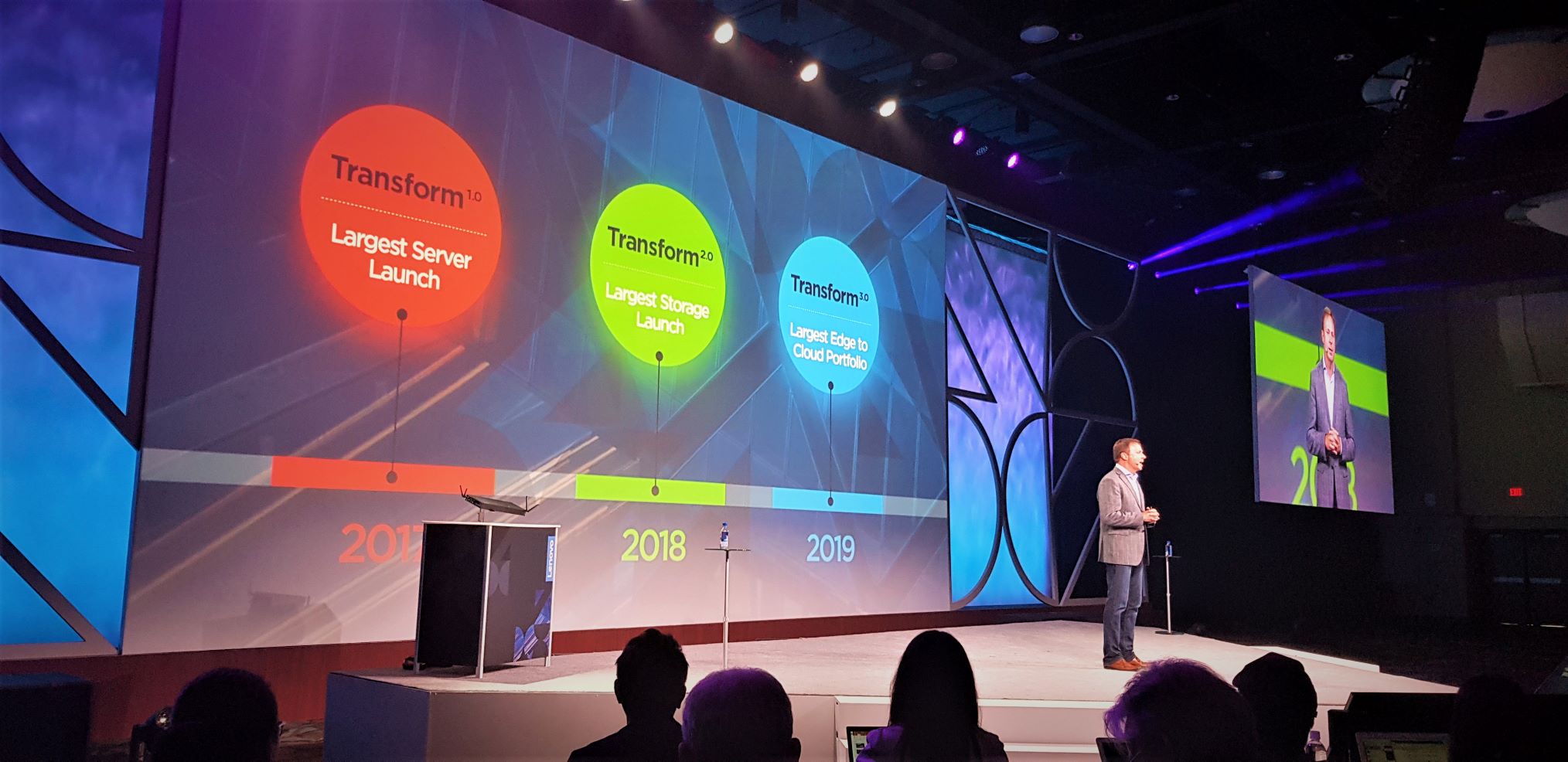
Think Lenovo, and you may think personal computing. You wouldn’t be wrong: laptops and desktops are the Chinese multinational’s bread and butter, accounting for 77 percent of revenues. The company has been aggressively pivoting into other markets under a strategy of “Intelligent Transformation” in recent years however – notably taking a growing bite out of the server and storage markets – and at its Lenovo Accelerate conference this week, showcased serious appetite for further diversification away from the consumer and toward the enterprise.
The move is paying off: despite stagnant PC sales in the last quarter driven by an industry-wide supply shortage of processors, gross profit margin is up to 14.6 percent and gross profit itself up 17 percent year-on-year on quarterly revenues of $14 billion.

At Lenovo Accelerate 3.0, a free-wheeling confidence about the company’s future opportunities was palpable as a result; as was the sheer ambition of a notably accessible and open executive team – this is not your usual Chinese company – as that pivot continues. While there was no shortage of new laptops, and even the prototype of a “folding PC“, the focus was firmly on greenfield opportunities: AR, edge computing, and IoT.
Lenovo Accelerate: Hyperscale, Yes, But Also More Edge, More IoT
Data centres remain hot for the company though (hyperscale revenue growth triple year-on-year in the last quarter) and Lenovo has a clear goal: “We want to be the largest hyperscale infrastructure provider in the world” Executive VP Kirk Skaugen said in a bullish keynote, pointing to the company’s ability to leverage its $40 billion in annual commodity acquisitions, its “worldclass manufacturing costs and supply chain” and its motherboard production facilities as key to continuing segment growth.
The company’s largest plant can produce a massive 20-25 million motherboards per year, he noted, but it’s not just scale that counts as buyers seek ever-more customised servers, e.g. for FGPA or GPU-driven workloads: “We can compete with OEMs and ODMs; we can do custom designs starting with a blank sheet of paper. We build memory. We build SSDs”, Skaugen said, dubbing the company’s approach ODM+ for its ability to provide standard and highly bespoke products (CSR is increasingly important to hyperscale partners too, the company noted, pointing to its efforts on that front).
Read this: Lenovo Takes on HoloLens with New AR Headset, Platform
While Lenovo’s Data Centre Group ambitions were clear, its push for an even more diversified portfolio is far from over though: the company is making a play for augmented reality hardware and services; for the IoT and for the telecommunications and networking sectors – across both the hardware and software stacks, pushing out products at Lenovo Accelerate on all of those counts and pledging to quadruple spending on IoT this year. (If Lenovo’s 2017’s emphasis was servers and 2018’s was storage, 2019’s is edge computing and telco/networking, with the company promising a radically scaled up portfolio of new hardware across those segments this year).

So, What’s New this Week?
A robust “edge” server first unveiled at Barcelona’s Mobile World Congress in February, the SE350, drew plenty of attention earlier this year for its ability to function at temperatures of 0° to 55°C, tolerate life in tough locations, low profile (it can be hung on a wall, mounted in a rack, stacked on a shelf, etc.) and built-in security features like key-encrypted storage, a locking bezel, intrusion and tamper-detection mechanisms.

The SE350 has now been joined by a baby brother, the ThinkCentre M90n-1 Nano IoT; a novella-sized computer designed to sit discreetly in edge environments where the needs for localised compute are matched by those for rugged and low-profile boxes.
Designed to operate without a fan in temperatures of up to 50o Celsius, the Nano IoT is a modified version of another new more consumer-facing release this week: the ThinkCentre M90n, which Lenovo dubbed the smallest desktop in the world. (See image above).
The Nano IoT enables “the rapid relay of information between connected IoT peripherals, sensors and devices, even in harsher commercial environments”, Lenovo said, adding that users can “drive further expansion of additional legacy ports and peripherals with the expansion I/O Box to build out to your edge device needs. One use case offered up: aeroplanes, where engine data needs to be processed fast, with tolerance for the latency that transmission to the cloud would entail.
(Also new, a smart camera, a cashless checkout prototype, and a partnership with Microsoft that puts Azure at the heart of Lenovo’s IoT efforts.)
Challenged on the commercial viability of competing in a heavily fragmented IoT landscape, Kirk Skaugen said: “The IoT challenge is not a cost challenge it’s an integration challenge. Our role is a tier role. There are over 200 IoT platforms out there competing. Our job is to make sure we integrate sideways with other platforms, then integrate solution bundles. But one thing is clear: nobody at the scale of Lenovo has walked into this market with our kind of focus. There’ll be vending machines out there with [Intel’s] Core i7 vPro in them. The next vending machines will do predictive analytics and say on a hot day we do more orange soda than Pepsi; they’ll do automated truck routing… run billing systems, tap to pay, smart signage.”
“It sounds crazy but it’s not far out.”

Telco Changes Could be Big BusinessCharles Ferland, Lenovo VP and GM, Comms Service Provider, said: “There is a transformation happening in the telco space. You can’t have purpose built equipment with a few functions any more. You need x86-based architecture that can run virtual machines; that’s how service providers are building Network Function Virtualisation. In that context, service providers are purchasing a lot more x86 servers than ever before.
“We are coming from an IT background, but now that the service providers are opening up to a more IT-like way of delivering their services, we are actually in a good position to deliver highly reliable servers and optimised and high-performance servers as well. In order to deliver this, it has to be done at scale: we’re talking about thousands of servers that need to be managed – and again, our hyperscale expertise comes in handy there – but I think more importantly is how those servers are distributed.”
“Most of the management systems we have [in the market] tend to manage 10,000 servers in two data centres. Now we are turning this upside down; there will be two servers in 10,000 locations. This is edge computing. But I cannot send a technician to 10,000 locations, you need to do a lot of remote administration. You need to be able to do zero-touch provisioning. That’s what we’re doing to help service providers go to market faster. Alongside the SE350 we’re trialling other prototypes with service providers. But it’s more than just the hardware: it’s about how we accelerate workloads and manage it in a secure way as well: data centres are well protected; but now servers are being deployed in base stations at the bottom of field somewhere, building tamper detection and other security into the hardware like we’ve done is vital.”
Skaugen added: “It’s interesting to see a server with antennas on it! But listen: you’ve heard the expression ‘the edge will eat the cloud’? Only 10 percent of data now is processed at the edge. A few years out, that will be 70 percent computed at the edge.” And Lenovo plans to be there.






